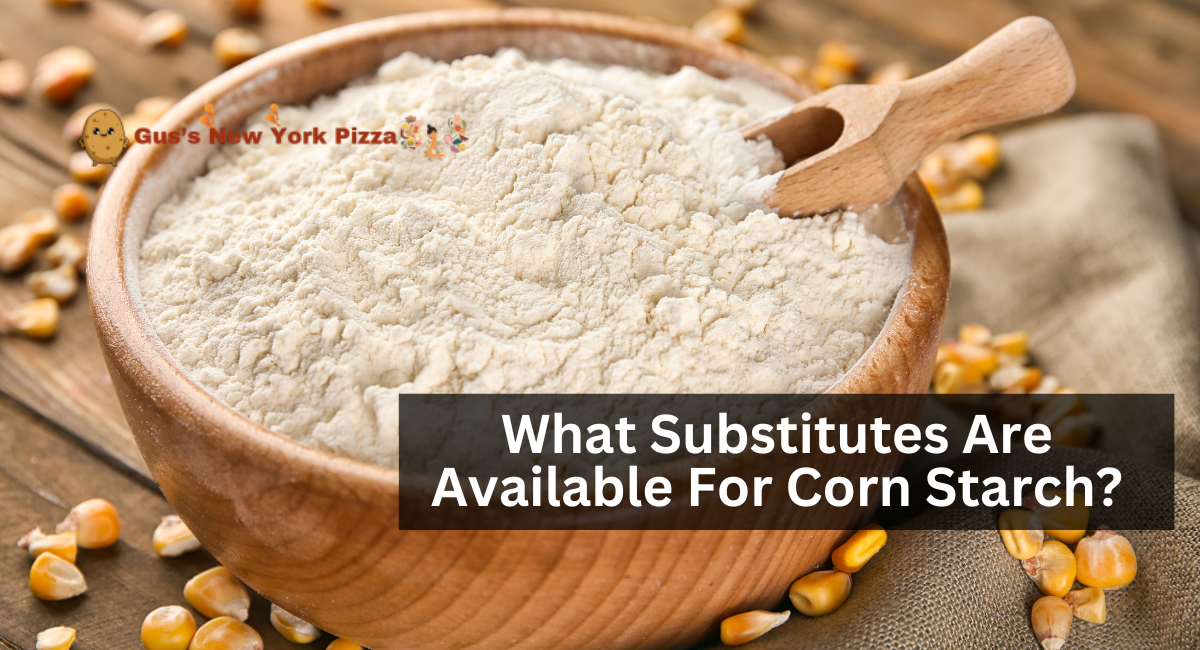In the world of cooking and baking, there are times when you run out of an important ingredient, such as cornstarch. Corn starch is crucial in thickening sauces, preparing puddings, and coating fried chicken. But Fret Not, for There Are Various Alternatives Readily Available in Your Kitchen That Can Step in as Substitutes for Corn Starch. In This Article, We’ll Explore These Alternatives and Show You How to Effectively Use Them.
Best Substitutes For Cornstarch
Here are some best substitute for cornstarch :
1. Potato Starch
Potato Starch Is Among the Best Cornstarch Substitutes Due to Its Nearly Equivalent Texture and Flavor Neutrality. It’s a fantastic thickener for sauces and works equally well in baked goods, such as shortbread. The best part is that it can be substituted in equal amounts, eliminating the need for mental calculations. These are merely a few of the many reasons why many cooks consider potato starch to be a superior alternative to cornstarch.
2. All-Purpose Flour
If you’ve ever made a Roux, you know how well regular all-purpose flour thickens sauces, gravies, and stews. It is not a great replacement for cornstarch. A sauce thickened with cornstarch will be clearer than one thickened with all-purpose flour. It Won’t Provide the Same Thin, Shatteringly Crisp Crust That Cornstarch Does for Some Fried Foods, but It Can Work in Either Case.
A few tips: Use two tablespoons of flour for every tablespoon of cornstarch. If you prepare a pan sauce, toast the flour in a bit of lard or boil the sauce for a few minutes to eliminate the “raw flour” flavor and texture.
3. Rice Flour
Rice Flour Is an Excellent Substitute for Cornstarch When Making Crispy, Craggy, and Shatteringly Crunchy Dredges for Fried Proteins, With One Exception: It Is Slightly More Expensive. If you need to use a substantial amount, the price of your cooking project may increase significantly.
You Can Still Substitute Rice Flour for Cornstarch in Recipes Such as Chicken Karaage and Harissa Honey Popcorn Chicken, and the Results Will Be Just as Crispy. However, rice flour should be used with caution as a thickener. Some Brands May Result in a Grittier or Gummier Texture. Seek out White Rice Flour that has Been Finely Milled for the Best Results.
4. Wheat Flour
Wheat is ground to a fine powder to produce wheat flour. Wheat Flour contains protein, fiber, and carbohydrates, unlike cornstarch. This indicates that cornstarch can be substituted for flour, but more flour will be required to achieve the same result.
Generally, it is suggested to use twice as much white flour as cornstarch when thickening. So, if a recipe calls for one teaspoon of cornstarch, you should use two teaspoons of white flour instead. Wheat and whole grain flour have more fiber than white flour, so you could try to thicken with them, but you’ll probably need a lot more of them to get the same result.
Mix Thicken Recipes with Wheat Flour with a Little Cold Water First to Form a Paste. When added to recipes, this will prevent them from clumping and sticking together. Remember That Wheat Flour Is Not Gluten-Free, So It Is Not Suitable for People with Gluten-Related Disorders If You Are Using Wheat Flour as a Cornstarch Substitute.
5. Tapioca Flour
Extracted from the Cassava Root, Tapioca Flour (Or Tapioca Starch) Is Among the Best Cornstarch Substitutes for Puddings and Sweet Sauces. Avoid Confusing This With Cassava Flour, Which Is More Fibrous and Produced Using the Whole Root. Tapioca Flour Is a Superb Thickener, but Be Careful Not to Use Too Much. Tapioca flour doesn’t have the same texture as cornstarch.
It Can Veer Into Gummy Territory If Used Excessively (If You’ve Had Bubble Tea or Boba, You’re Aware of Tapioca’s Potential Chew Factor). Use Twice as Much Tapioca Flour to Replace Cornstarch in Your Recipe, and Do Not Overheat or Boil for an Excessive Time. Use it in jammy fruit pie fillings or sweets like this plum-cardamom crumble with pistachios or a jiggly custard tart with cream and fresh fruit.
6. Arrowroot Powder
Arrowroot Powder is also referred to as Arrowroot Starch or Arrowroot Flour, and it is derived from the roots of several tropical plants, including cassava. It’s commonly used to lend airiness to gluten-free and vegan treats, but it can also be used as a thickening agent, similar to cornstarch, but it’s a little more picky. When heated, arrowroot does not behave well and tends to thin out.
Therefore, Use It in Recipes Where You Don’t Need to Worry About Direct Heat or a Long Simmer, Such as Desserts. Start by Dissolving It in Cold Water (A Ratio of Arrowroot Powder to Cornstarch of 1 to 1 Should Do the Trick) Before Slowly Adding to Room-Temperature Sauces.
7. Xanthan Gum
If you do not have cornstarch in your pantry, you probably do not have xanthan gum. It is a common thickener that is often made by fermenting cornstarch. If you have a corn allergy, be careful! It is often used in gluten-free baking recipes to mimic the stretchiness of wheat flour. For Sauces and Gravies, You Only Need a Small Amount of Tapioca Starch as a Substitute for Cornstarch. Consider a Half Teaspoon for a Whole Pan of Gravy. Start Very Slowly and Increase as Required.
8. Kuzu Starch
Kuzu Starch, also known as Kudzu Starch, is a popular ingredient in East Asian cuisine. It is an all-purpose thickening agent similar to cornstarch. Kuzu Is a Raw Ingredient That Must Be Cooked; the Longer It Is Cooked, the Denser It Becomes.” Ikeda uses Kuzu Starch as a setting agent in her recipe for vegan Panna Cotta; it gives the dessert a bouncy texture that mochi fans will appreciate.
Kuzu Starch Can Be Used as a 1:1 Cornstarch Substitute to Thicken Sauces, Soups, and Desserts.
Thanks for visiting our site hope you like it ..










